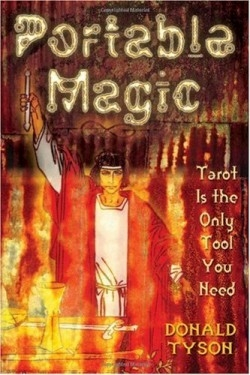
Portable Magic
Tarot is the Only Tool You Need
Many people think of magic as sleight-of-hand stage performance, and assume that tarot cards are only used as divination devices for “fortune telling.” The author dispels both misconceptions in a book that is part magical instruction and part history of tarot symbolism.
Ceremonial magic, sometimes called ritual magic, is the act of focusing and sending energy to obtain a desired result. It proliferated during the Renaissance, practiced by proto-scientists, philosophers, and even clergy. Normally, it requires a ritual space, special garb, and much accoutrement to effect its purpose.
Tyson simplifies this by using only a portable tarot deck, which can be carried anywhere. “Tarot magic requires no expensive materials or handcrafted tools, no incense, no candles, no oils, no arcane languages, no special place in which to work, no costly robes or talismans.” By placing certain cards in prescribed patterns, the magician is able to focus his mind and carry out the magical act.
The author’s use of tarot for magic is based on the tarot correspondences developed by the Hermetic Order of the Golden Dawn (HOGD), founded in 1888 by freemasons and dedicated to studying and practicing magic for the betterment of humanity. A correspondence is a specific association between two or more concepts. For example, the tarot card called Justice corresponds to the astrological sign Libra. The HOGD’s complex tarot symbolism wove together astrology and Kabbalah. Though most tarot users are somewhat familiar with this symbolism, Tyson’s concise yet thorough analysis clarifies its origin and function.
Tyson, himself a ceremonial magician and the author of thirty-one books, deftly describes the different components of ceremonial magic (the point, the ray, the circle, the triangle, and the cross), and discusses how to use tarot cards as substitutes for whatever a magician would normally use in the rites. Thus, three cards placed in the shape of a triangle represent a pyramid, and function to draw energy through the apex point; four cards in the shape of a cross stand for a ceremonial altar as the locus of interaction with the spirit world, and so on.
He includes three sample rituals (for banishing, business, and psychic union), illustrating how to put the principles of tarot magic into action. He instructs readers on tarot charms, “for the realization of sustained purposes,” like attracting love or protecting one’s house. An appendix discusses possible modifications to HOGD tarot symbolism; a glossary of tarot and magic terms completes the volume.
Tyson writes tightly, and interesting bits of lore keep the text lively. For example, abracadabra is a real word, possibly originating in the ancient Chaldean phrase Abbada ka dabra, meaning “perish like the word.” It was used in antiquity to banish fevers.
Portable Magic can be read as a “how-to” manual on ritual energy sending, or a reference guide to HOGD symbolism in tarot. It succeeds beautifully on both counts.
Reviewed by
Leah Samul
Disclosure: This article is not an endorsement, but a review. The publisher of this book provided free copies of the book to have their book reviewed by a professional reviewer. No fee was paid by the publisher for this review. Foreword Reviews only recommends books that we love. Foreword Magazine, Inc. is disclosing this in accordance with the Federal Trade Commission’s 16 CFR, Part 255.
